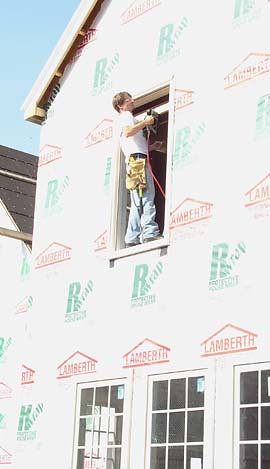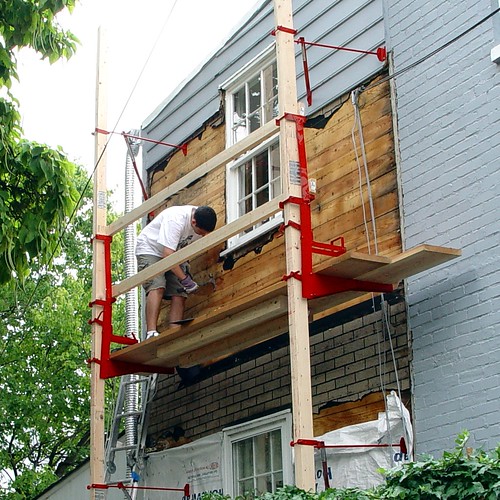Though our siding to do list was growing rather than shrinking, we had accomplished most everything we could without addressing the ugly nine headed gorilla in the room of "how are we going to work up high on the side of the house?"
- What kind of siding should we use?
- What additional tools will we need?
- How am I going to do the work all the way at the top of the house?
- Research replacement gutters
It was a simple dilemma, but one whose solution seemed to evade us. We were faced with a very narrow alley to the side of our home and about 22 vertical feet we had to somehow scale while first removing, then preparing for, then installing a whole lot of siding.
The answer to our quandary seemed simple enough: "put up scaffolding." But having never worked on scaffolding, let alone with actually building my own scaffolding, I feared going this route was yet another recipe in our smorgasbord for disaster, and I was the main ingredient in this course of the meal.
I tried to noodle my way trough my dilemma, albeit unsuccessfully, but coming up with a series of brilliant ideas that made a simpleton resemble Mike Holmes. My internal dialog was like an arguing six year old trying desparately to come up with a solution over all logic.
I thought:
"Could I lean ladders up against the house and just do all of my work that way?"
No!! Bad, bad, bad, and I mean very BAD idea trying to wrangle siding lengths and tools up and down ladders in such a tight alley. House painting on ladders is one thing, trying to shimmy, move, and deal with ladders while hoisting and nailing lengths of siding is not something I wanted to he part of, primarily because I had somehow never gained the gift of flight or levitation to compensate for my inevitable failure to stay planted firmly on the rungs of the ladder. So that was out of the question.
"Could I just hang out of the window somehow?"

Photo Credit: Enon Hall
Wow, and I thought the ladder idea was stupid. What was I going to do, tie a rope around my waist and have Wendy hold it from the inside? It worked for Bill of Enon Hall to install window trim, but a whole siding job? Nope, I killed that idea before it sprouted wings and had a chance to actually kill me.
"What about a cherry picker?"
Okay, renting a cherry picker might have actually worked, and I would have had a killer toy for a little while, giving neighborhood friends rides up and down the street at about 25 feet above the ground. But if we went this route how long would we have needed it? How expensive would that have been? What about the really long pieces, wouldn't I need help on both sides? How do you drive and where do you park one of these? Would I get pulled over if I were driving it up and down the street (because there's almost no way I wouldn't do that)? And what's the likelihood I'd somehow lose control of the basket and end up either driving myself into power lines or tipping the whole thing over while hoisted many feet above the ground? I've watched YouTube, I know what happens. Back to the drawing board.
Through all of our options, a scaffolding system seemed to be the most straight forward, realistic, and possibly safest way about this problem. But have you looked at the various options for scaffolding lately? You have everything ranging from the most basic and death defying...
...to the more expensive and complex to assemble.
Though we could have rented a larger system, I worried about how long we'd need it, how much it would cost, how easily we could build it ourself, and how we'd actually get it from the store to our house in our tiny Mustang. Most systems consisted of poles and walk planks much longer than three of our car could accommodate, let alone just one small trunk.
There we were, stuck, so many options, so little know how. That's when a coworker of Wendy's at the time, who is also a home enthusiast (that name is so much better than "DIYer") offered up a suggestion. He and his wife had done some similar work in the past and used a scaffolding product called "Pump Jack."
The Qualcraft Pump Jack Steel scaffolding system consists of only the items necessary for affixing the system to the wall and to support and lift/lower the walking platform, the rest of the system can be built from standard off the shelf lumber.
After this Home Enthusiast told us about the system I immediately started looking around and researching. It seemed too good to be true.
For this system to work I'd only need to purchase two foot operated lift mechanisms and six post support strut systems. I started looking around at various online outlets and found what I needed for sale on eBay. Total price for everything I needed was only about $150.
Before I pulled the eBay trigger I also priced out rental of the same or similar equipment and found it would be at least $150 and perhaps more, given our uncertain rental duration. With a little more courage in knowing this system was recommended by other Home Renovation Ninjas (Side note: that's a lame title. Any time you refer to yourself or others as a "Ninja" or that you use "Ninja tactics" and you are serious, you are incredibly lame.) I went ahead and made the purchase.
When the scaffolding arrived I met it with both anticipation and a good dose of intimidation. Even with an assurance that "almost anyone can do this," I knew that it wasn't going to be a particularly easy chore.
I took all of my measurements and determined I'd need two 24' long 4x4 posts, one for each side of the scaffolding, and a 12' long walking plank with a 10' foot unsupported span.
For the posts I'd have difficulty both acquiring and then hauling/handling 24' 4x4 poles, so I used a trick shown on the Qualcraft website. I screwed several pieces of 2x4 together with staggered joints, making the 24' length I'd need, but I only needed to purchase six 2x4s for each post.
The walk plank was a little more difficult. You're only supposed to use regular lumber on an 8' unsupported span, and my span was going to be longer, making it more dangerous to place too much weight on the walk board. The last thing I needed was for my scaffolding to come crashing down while at full height. If I survived the fall, Wendy's ongoing ridicule and "I told you so" mentality would last an eternity.
I ended up buying two 12' lengths a of tight grain 2x10 lumber, and then I screwed a 10' 2x4 to the underside of each walk plank in a perpendicular manner. This gave the walk planks the additional structure we needed, ensuring the planks would easily support us while working on the wall, reducing the risk of injury, and saving me from Wendy's onslaught.
Feeling good about our decisions and progress we decided to go ahead and construct our scaffolding, and this is where things got a little dicey.
Now I don't know if you have ever tried to hoist a 24' long 4x4 pole into a vertical position with two people (one as the lifter, and one as the spotter), but it's a task that possesses a certain level of difficulty on par with transferring a velociraptor between two cages. Not familiar? It's deceptively hard.
As I began hoisting the first pole into place, the whole task started out rather simply and without issue. After gaining a false sense of confidence in my ability to successfully navigate this tricky endeavor, I passed the 45 degree mark on the way to perpendicular and noticed the pole begin to dance due to outside forces...like those of physics and gravity. Undeterred, and not looking to give up the fight, I persevered and continued with the cage transfer of this seemingly docile yet unpredictable beast.
By the time I reached completely vertical I began to tire, my arms began to shake, and I swear I glimpsed the knowing eye of this 4x4 beast glaring at me through the rungs of the cage, and it was a hungry and devious eye. I was lulled by the near completion of the lift as Wendy moved into position to secure the first strut in place and I allowed my attention to lapse for only a moment. The large 24' long velociraptor of lumber seized its opportunity to strike and began to tip at an ever increasing rate until I and my hulking 5'10" 155 pound frame was unable to stop the momentum, simply along for the ride. The pole careened through the air, ripping through anything in it's way. During the fall it collided with several unfortunate branches and a telephone line that once crossed our backyard. The Jurassic building materials devoured the telephone wire, ripped apart the branches, and ultimately scored a direct impact on my unprotected noggin and shoulder before coming to an innocent rest on the ground.
Woozy from the impact, and not wanting to accept failure, I took a moment to collect my hazy thoughts and shoo the stars from my vision. After a brief hydration break, Wendy and I gave it another shot, only this time I did so with the knowledge that this sleepy beast could strike at any moment. After another minute or two of struggles the pole was once again upright and Wendy quickly secured it to the wall. Victory! And with only a minor head wound and aching body to show for it.
The scaffolding itself was quite simple to setup and configure. The brilliance of the simplicity is in the lift mechanism. It uses a foot operated pumping type motion to raise the scaffolding one push at a time. Each pump locks the walk plank a little higher than the previous pump. Alternating from side to side, I'd raise one side by three or four pumps, then the other by the same. After a few minutes, I was at the specific height I'd need to work on the siding.
The whole time I was working up on the scaffolding I felt very safe and secure. I added a few 2x4 guard rails to make sure I wouldn't end up taking a header off the back side of the plank. And best of all, the whole system was secure and sturdy enough for two people to work up there together without issue.
Though truly intimidating, the task of determining and then setting up a scaffolding system was one of the most fulfilling of our DIY careers. The process of researching and selecting the system made us feel like we might, just might, be able to pull off this very difficult task. We still had quite a long way to go, and Wendy's fear of heights added an unexpected wrinkle to the whole project, but we were feeling good, ready to take on the task.
Have you ever had to work up high on any project? Did you use scaffolding, ladders, a cherry picker, or some other magical lift system? If you've never worked up that high, what are your thoughts on height? Could you handle it?

![]()
![]()